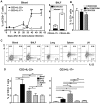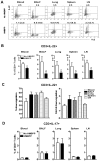Differentiation, distribution and gammadelta T cell-driven regulation of IL-22-producing T cells in tuberculosis
- PMID: 20195465
- PMCID: PMC2829073
- DOI: 10.1371/journal.ppat.1000789
Differentiation, distribution and gammadelta T cell-driven regulation of IL-22-producing T cells in tuberculosis
Abstract
Differentiation, distribution and immune regulation of human IL-22-producing T cells in infections remain unknown. Here, we demonstrated in a nonhuman primate model that M. tuberculosis infection resulted in apparent increases in numbers of T cells capable of producing IL-22 de novo without in vitro Ag stimulation, and drove distribution of these cells more dramatically in lungs than in blood and lymphoid tissues. Consistently, IL-22-producing T cells were visualized in situ in lung tuberculosis (TB) granulomas by confocal microscopy and immunohistochemistry, indicating that mature IL-22-producing T cells were present in TB granuloma. Surprisingly, phosphoantigen HMBPP activation of Vgamma2Vdelta2 T cells down-regulated the capability of T cells to produce IL-22 de novo in lymphocytes from blood, lung/BAL fluid, spleen and lymph node. Up-regulation of IFNgamma-producing Vgamma2Vdelta2 T effector cells after HMBPP stimulation coincided with the down-regulated capacity of these T cells to produce IL-22 de novo. Importantly, anti-IFNgamma neutralizing Ab treatment reversed the HMBPP-mediated down-regulation effect on IL-22-producing T cells, suggesting that Vgamma2Vdelta2 T-cell-driven IFNgamma-networking function was the mechanism underlying the HMBPP-mediated down-regulation of the capability of T cells to produce IL-22. These novel findings raise the possibility to ultimately investigate the function of IL-22 producing T cells and to target Vgamma2Vdelta2 T cells for balancing potentially hyper-activating IL-22-producing T cells in severe TB.
Conflict of interest statement
The authors have declared that no competing interests exist.
Figures





Similar articles
-
Th17-related cytokines contribute to recall-like expansion/effector function of HMBPP-specific Vγ2Vδ2 T cells after Mycobacterium tuberculosis infection or vaccination.Eur J Immunol. 2015 Feb;45(2):442-51. doi: 10.1002/eji.201444635. Eur J Immunol. 2015. PMID: 25141829 Free PMC article.
-
Multifunctional immune responses of HMBPP-specific Vγ2Vδ2 T cells in M. tuberculosis and other infections.Cell Mol Immunol. 2013 Jan;10(1):58-64. doi: 10.1038/cmi.2012.46. Epub 2012 Nov 12. Cell Mol Immunol. 2013. PMID: 23147720 Free PMC article. Review.
-
Immunization of Vγ2Vδ2 T cells programs sustained effector memory responses that control tuberculosis in nonhuman primates.Proc Natl Acad Sci U S A. 2019 Mar 26;116(13):6371-6378. doi: 10.1073/pnas.1811380116. Epub 2019 Mar 8. Proc Natl Acad Sci U S A. 2019. PMID: 30850538 Free PMC article.
-
Cytokine requirements for the differentiation and expansion of IL-17A- and IL-22-producing human Vgamma2Vdelta2 T cells.J Immunol. 2010 Jun 15;184(12):7268-80. doi: 10.4049/jimmunol.1000600. Epub 2010 May 14. J Immunol. 2010. PMID: 20483730 Free PMC article.
-
Protective immune responses of major Vγ2Vδ2 T-cell subset in M. tuberculosis infection.Curr Opin Immunol. 2016 Oct;42:105-112. doi: 10.1016/j.coi.2016.06.005. Epub 2016 Aug 1. Curr Opin Immunol. 2016. PMID: 27491008 Free PMC article. Review.
Cited by
-
Interleukin-22 is elevated in lavage from patients with lung cancer and other pulmonary diseases.BMC Cancer. 2016 Jul 7;16:409. doi: 10.1186/s12885-016-2471-2. BMC Cancer. 2016. PMID: 27388918 Free PMC article.
-
Th22 Cells Are a Major Contributor to the Mycobacterial CD4+ T Cell Response and Are Depleted During HIV Infection.J Immunol. 2021 Sep 1;207(5):1239-1249. doi: 10.4049/jimmunol.1900984. Epub 2021 Aug 13. J Immunol. 2021. PMID: 34389623 Free PMC article.
-
Multidrug-resistant tuberculosis (MDR-TB) strain infection in macaques results in high bacilli burdens in airways, driving broad innate/adaptive immune responses.Emerg Microbes Infect. 2018 Dec 12;7(1):207. doi: 10.1038/s41426-018-0213-z. Emerg Microbes Infect. 2018. PMID: 30538219 Free PMC article.
-
Interleukin 22 inhibits intracellular growth of Mycobacterium tuberculosis by enhancing calgranulin A expression.J Infect Dis. 2014 Feb 15;209(4):578-87. doi: 10.1093/infdis/jit495. Epub 2013 Sep 16. J Infect Dis. 2014. PMID: 24041785 Free PMC article.
-
Predominance of interleukin-22 over interleukin-17 at the site of disease in human tuberculosis.Tuberculosis (Edinb). 2011 Nov;91(6):587-93. doi: 10.1016/j.tube.2011.06.009. Epub 2011 Jul 20. Tuberculosis (Edinb). 2011. PMID: 21767990 Free PMC article.
References
-
- Wolk K, Sabat R. Interleukin-22: a novel T- and NK-cell derived cytokine that regulates the biology of tissue cells. Cytokine Growth Factor Rev. 2006;17:367–380. - PubMed
-
- Wolk K, Kunz S, Witte E, Friedrich M, Asadullah K, et al. IL-22 increases the innate immunity of tissues. Immunity. 2004;21:241–254. - PubMed
Publication types
MeSH terms
Substances
Grants and funding
LinkOut - more resources
Full Text Sources
Medical

